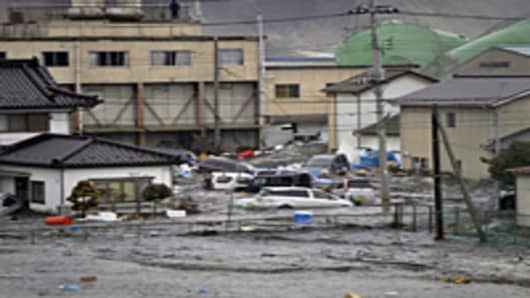The events in Japan over the last 4 days have been riveting and all other news has taken a back seat. The consensus in the market is that this is a short-term negative event that will not have a lasting impact on the Japanese economy. Japan comprises around 8-9% of the global economy and therefore will not have a significant impact.
In my book "World Event Trading", I wrote that earthquakes and tsunamis are the enigmas of the financial disaster universe.
"They occur with no warnings and surprise even the most sophisticated prediction models. For the trader, these are reaction events that force one to digest and analyze within minutes of their existence. They are paradoxical in that the largest earthquakes and tsunamis don’t necessarily produce an event to trade nor do they always produce severe economic damage. It’s all about when and where. These disasters are nature’s way of giving the earth a heart attack. However like hurricanes, though, the usual suspects of insurance companies and construction sectors are impacted."
The market’s initial reaction to the earthquake and tsunami remained consistent with what I wrote. The USD against JPY rallied above 83.00 on Friday and then retraced all the way to 80.70 in early Far East trading today. The yen strength was originally believed to be predicated upon repatriation of foreign investments by Japanese that were sold to be brought back. (There was also discussion of insurance companies buying yen to make payments on policies, but this was a bit early.)
Many in the market cited the Kobe earthquake on January 16, 1995 as an example of what would happen now. While the yen did eventually strengthen over the next four months, there reasons were not necessarily tied to repatriation and likely were influenced by the FOMC signaling it was done raising interest rates in February (and a surprise cut in the summer).
After the lows reached today, the USD has rallied back to 82.40 and now trades around 81.60. The Bank of Japan has pumped in 14-15 trillion yen into the markets ($183 billion) and made available another 6 trillion yen over the next 2 days. The Ministry of Finance has said that they are closely mentoring the movements of the currency.
Unlike the currency, the stock market was almost a one way bet down and this is consistent with what happened after Kobe. Also, the Japanese government 10 year bond has rallied and that is also consistent with Kobe. Both the Nikkei and JGBs (yield) were trading soft after recent rallies. Back to the book, "As in our entire event trading examples, we look for situations in which the event provides an opportunity to either accelerate a trend or provide a reversal (sometimes brief) to a trend. In this case (Kobe), the market was soft and the event drove it further in that direction."
To sum it up, the horrific events in Japan have had a devastating human and economic cost. For the markets, they are behaving consistent with previous natural disasters that have occurred throughout recent history. This translates into a lower stock market, lower government bond yields and a mixed outcome for the currency (subject to other countries' monetary policy).
CURRENCY FUTURES:
Andrew B. BuschDirector, Global Currency and Public Policy Strategist at BMO Capital Markets, a recognized expert on the world financial markets and how these markets are impacted by political events, and a contributor to CNBC's Money in Motion Currency Trading.You can comment on his piece and reach him hereand you can follow him on Twitter at http://twitter.com/abusch.
Tune In: Beginning March 11th, CNBC's "Money in Motion Currency Trading" will air on Fridays at 5:30pm.
"Money in Motion Currency Trading" will repeat on Saturdays at 7pm.



